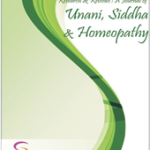
Md. Rizwanullah,

Minhaj Ahmad,
- Assistant Professor Department of Jarahiyat (Surgery), School of Unani Medical Education and Research, Jamia Hamdard. New Delhi India
- HoD & Professor Department of Jarahiyat (Surgery), School of Unani Medical Education and Research, Jamia Hamdard. New Delhi India
Abstract
Diabetic foot ulcer (DFU) is a distressing complication of diabetes mellitus. It is encountered in about 15% of patients living with DM. It is a major cause of morbidity and mortality. The patients with DFU are at the risk of prolonged hospitalization, infection, gangrene, amputation, and even death if effective wound care faculties are not provided. It is anticipated that approximately 50%-70% of all lower limb amputations are due to DFU. According to estimation, in every 30second one leg is amputated due to DFU. The management of DFU has always been a challenging task as the ulcer shows no tendency toward healing. It is very difficult to treat such ulcer with conventional methods of antiseptic dressing and it requires prolonged hospitalization. In view of higher incident of DFU and non-availability of the affordable treatment, the present study was designed to access the effect of the Unani formulation containing Sibr Zard, Amba Haldi, Mur Makki, and Gulnar in the treatment of the Diabetic foot ulcer (DFU). After proper cleaning of the wound with Neem (Azadirachta Indica) leave water, a fine powder of the test drugs: Sibr Zard, Amba Haldi, Mur Makki, and Gulnar was sprinkled over the wound and dressing done with sterilized gauze piece and bandage were applied. Dressing was done regularly under full aseptic precaution. At the end of 150 days of study 97.7 percent of healing of the ulcer achieved.
Keywords: Diabetic foot ulcer, Qurooh-E-Aseerul-Indimal, Unani medicine.
References
- Shahbazian H, Yazdanpanah L, Latifi SM. Risk assessment of patients with diabetes for foot ulcers according to risk classification consensus of International Working Group on Diabetic Foot (IWGDF) Pak J Med Sci. 2013;29:730–734
- Ramachandran A, Snehalatha C, Shetty AS, Nanditha A. Trends in prevalence of diabetes in Asian countries. World J Diabetes. 2012;3:110–117.
- Shaw JE, Sicree RA, Zimmet PZ. Global estimates of the prevalence of diabetes for 2010 and 2030. Diabetes Res Clin Pract. 2010;87:4–14.
- Whiting DR, Guariguata L, Weil C, Shaw J. IDF diabetes atlas: global estimates of the prevalence of diabetes for 2011 and 2030. Diabetes Res Clin Pract. 2011;94:311–321.
- Aalaa M, Malazy OT, Sanjari M, Peimani M, Mohajeri-Tehrani M. Nurses’ role in diabetic foot prevention and care; a review. J Diabetes Metab Disord. 2012;11:24.
- Ghani AHN. Khazain-ul-Adviya. Delhi; Idara Kitab-us-shifa;YNM.
- Cavanagh PR, Lipsky BA, Bradbury AW, Botek G. Treatment for diabetic foot ulcers. 2005;366:1725–1735.
- Leone S, Pascale R, Vitale M, Esposito S. [Epidemiology of diabetic foot] Infez Med. 2012;20 Suppl 1:8–13.
- Richard JL, Schuldiner S. [Epidemiology of diabetic foot problems] Rev Med Interne. 2008;29 Suppl 2:S222–S230.
- Kabeeruddin A. Makhzan-ul-Mufradat. Delhi; Idara Kitab-us-shifa: 2007.
- Bakri FG, Allan AH, Khader YS, Younes NA, Ajlouni KM. Prevalence of Diabetic Foot Ulcer and its Associated Risk Factors among Diabetic Patients in Jordan. J Med J. 2012;46:118–125.
- Iraj B, Khorvash F, Ebneshahidi A, Askari G. Prevention of diabetic foot ulcer. Int J Prev Med. 2013;4:373–376.
- Fard AS, Esmaelzadeh M, Larijani B. Assessment and treatment of diabetic foot ulcer. Int J Clin Pract. 2007;61:1931–1938.
- Snyder RJ, Hanft JR. Diabetic foot ulcers–effects on QOL, costs, and mortality and the role of standard wound care and advanced-care therapies. Ostomy Wound Manage. 2009;55:28–38.
- Vileikyte L. Diabetic foot ulcers: a quality of life issue. Diabetes Metab Res Rev. 2001;17:246–249.
- Ragnarson Tennvall G, Apelqvist J. Health-economic consequences of diabetic foot lesions. Clin Infect Dis. 2004;39 Suppl 2:S132–S139.
- Boulton AJ, Vileikyte L, Ragnarson-Tennvall G, Apelqvist J. The global burden of diabetic foot disease. 2005;366:1719–1724.
- Hakeem HA. Bustan-ul-Mufradat. Delhi; Idara Kitab-us-shifa;YNM.
- CP. Indian Medicinal Plants-An Illustrated Dictionary. 1st ed. New York: Springer Science + Business Media; 2007.
- RN, Nayar SL, Chopra IC. Glossary of Indian Medicinal Plants. 1stNew Delhi: National Institute of Science Communication and InformationResource (CSIR); 2009.

Research & Reviews : A Journal of Unani, Siddha and Homeopathy
| Volume | |
| Received | July 9, 2024 |
| Accepted | July 20, 2024 |
| Published | July 22, 2024 |

